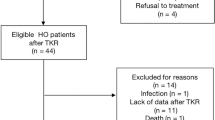Abstract
The objective of this study was to evaluate the degree of improvement in the range of movement in the knee joint, sitting ability, and overall ambulation in patients with heterotopic ossification of the knee joint who underwent surgical excision of ectopic bone. Between 1999 and 2006, 14 patients (23 joints) with significant heterotopic ossification of the knee joint that required surgery were evaluated. We compared the range of movement in the knee joint, sitting ability, and overall ambulation in the preoperative and postoperative periods using the Fuller and Keenan classification systems. Range of movement increased in 82% of cases (19 knee joints). Sitting ability improved in 13 patients (93%). Postoperatively, ambulation in eight patients (57%) was remarkably superior. In conclusion, resection of heterotopic ossification may significantly improve the range of movement in the knee joint, sitting ability, and overall ambulation.
Résumé
Le but de l’étude était d’évaluer l’amélioration de la mobilité, la capacité de s’asseoir et les capacités de déambulation après excision chirugicale des ossifications hétérotopiques du genou survenues après séjour en réanimation. Quatorze patients (23 genoux) opérés entre 1999 et 2006 sont étudiés en utilisant le système de classification de Fuller et Keenan. L’amplitude de mouvement s’améliore dans 82% des cas (19 articulations). La capacité de s’asseoir s’améliore chez 13 patients (93%) et les capacités de déambulation étaient nettement supérieures chez 8 patients. La résection de ces ossifications hétérotopiques est donc justifiée.




Similar content being viewed by others
References
Ahrengart L, Lindgren U (1993) Heterotopic bone after hip arthroplasty. Defining the patient at risk. Clin Orthop Relat Res 293:153–159
Ahrengart L, Sahlin K, Lindgren U (1987) Myositis ossificans after total hip replacement and perioperative muscle ischemia. J Arthroplasty 2:65–69
Argyropoulou MI, Kostandi E, Kosta P, Zikou AK, Kastani D, Galiatsou E, Kitsakos A, Nakos G (2006) Heterotopic ossification of the knee joint in intensive care unit patients: early diagnosis with magnetic resonance imaging. Crit Care 10:R152
Charnley G, Judet T, Garreau de Loubresse C, Mollaret O (1996) Excision of heterotopic ossification around the knee following brain injury. Injury 27:125–128
Coventry MB, Scanlon PW (1981) The use of radiation to discourage ectopic bone. A nine-year study in surgery about the hip. J Bone Joint Surg Am 63:201–208
DeLee J, Ferrari A, Charnley J (1976) Ectopic bone formation following low friction arthroplasty of the hip. Clin Orthop Relat Res 121:53–59
Errico TJ, Fetto JF, Waugh TR (1984) Heterotopic ossification. Incidence and relation to trochanteric osteotomy in 100 total hip arthroplasties. Clin Orthop Relat Res 190:138–141
Fuller DA, Mark A, Keenan MA (2005) Excision of heterotopic ossification from the knee: a functional outcome study. Clin Orthop Relat Res 438:197–203
Gacon G, Deidier C, Rhenter JL, Minaire P (1978) [Ectopic bone formation in neurological lesions (author’s transl)]. Rev Chir Orthop Reparatrice Appar Mot 64:375–390
Garland DE (1988) Clinical observations on fractures and heterotopic ossification in the spinal cord and traumatic brain injured populations. Clin Orthop Relat Res 233:86–101
Garland DE (1991) Surgical approaches for resection of heterotopic ossification in traumatic brain-injured adults. Clin Orthop Relat Res 263:59–70
Garland DE, Blum CE, Waters RL (1980) Periarticular heterotopic ossification in head-injured adults. Incidence and location. J Bone Joint Surg Am 62:1143–1146
Gaur A, Sinclair M, Caruso E, Peretti G, Zaleske D (2003) Heterotopic ossification around the elbow following burns in children: results after excision. J Bone Joint Surg Am 85:1538–1543
Kaplan FS, Glaser DL, Hebela N, Shore EM (2004) Heterotopic ossification. J Am Acad Orthop Surg 12:116–125
Kaplan FS, Glaser DL, Shore EM, Pignolo RJ, Xu M, Zhang Y, Senitzer D, Forman SJ, Emerson SG (2007) Hematopoietic stem-cell contribution to ectopic skeletogenesis. J Bone Joint Surg Am 89:347–357
Keenan MA, Creighton J, Garland DE, Moore T (1984) Surgical correction of spastic equinovarus deformity in the adult head trauma patient. Foot Ankle 5:35–41
Lane JE, Dean RJ, Foulkes GD, Chandler PW (2002) Idiopathic heterotopic ossification in the intensive care setting. Postgrad Med J 78:494–495
Major P, Resnick D, Greenway G (1980) Heterotopic ossification in paraplegia: a possible disturbance of the paravertebral venous plexus. Radiology 136:797–799
Melamed E, Robinson D, Halperin N, Wallach N, Keren O, Groswasser Z (2002) Brain injury-related heterotopic bone formation: treatment strategy and results. Am J Phys Med Rehabil 81:670–674
Neal BC, Rodgers A, Clark T, Gray H, Reid IR, Dunn L, MacMahon SW (2000) A systematic survey of 13 randomized trials of non-steroidal anti-inflammatory drugs for the prevention of heterotopic bone formation after major hip surgery. Acta Orthop Scand 71:122–128
Potter BK, Burns TC, Lacap AP, Granville RR, Gajewski DA (2007) Heterotopic ossification following traumatic and combat-related amputations. Prevalence, risk factors, and preliminary results of excision. J Bone Joint Surg Am 89:476–486
Sarafis KA, Karatzas GD, Yotis CL (1999) Ankylosed hips caused by heterotopic ossification after traumatic brain injury: a difficult problem. J Trauma 46:104–109
Saudan M, Saudan P, Perneger T, Riand N, Keller A, Hoffmeyer P (2007) Celecoxib versus ibuprofen in the prevention of heterotopic ossification following total hip replacement: a prospective randomised trial. J Bone Joint Surg Br 89:155–159
Seegenschmiedt MH, Keilholz L, Martus P, Goldmann A, Wölfel R, Henning F, Sauer R (1997) Prevention of heterotopic ossification about the hip: final results of two randomized trials in 410 patients using either preoperative or postoperative radiation therapy. Int J Radiat Oncol Biol Phys 39:161–171
Author information
Authors and Affiliations
Corresponding author
Rights and permissions
About this article
Cite this article
Mitsionis, G.I., Lykissas, M.G., Kalos, N. et al. Functional outcome after excision of heterotopic ossification about the knee in ICU patients. International Orthopaedics (SICOT) 33, 1619–1625 (2009). https://doi.org/10.1007/s00264-008-0618-8
Received:
Accepted:
Published:
Issue Date:
DOI: https://doi.org/10.1007/s00264-008-0618-8




